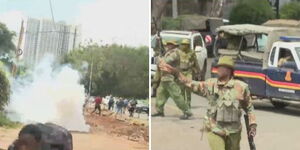The next time you see a government car, ambulance, hearse, or luxury car, it may not be carrying a government official, patient, or a diseased person. Rather, it may be transporting cannabis, a new report has shown.
Government vehicles, ambulances, and hearses are among the cars that drug traffickers trafficking cannabis are now using in a new strategy to evade arrest.
The report by the National Crime Research Centre (NCRC) dated Monday, November 11 has revealed that the traffickers use a different range of vehicles to traffic this drug, among them are government vehicles.
According to the report, traffickers utilize a variety of vehicles including high-end private cars like Land Cruisers, Prados, and Range Rovers. Common vehicles like Toyota Proboxes, public transportation like buses and matatus, boats, and even light aircraft are also used to transport cannabis to different parts of the country.
The traffickers employ government vehicles, rental cars, motorcycles, ambulances, hearses, cargo trucks, ships, and courier services just to ensure the drugs get to the desired destinations.
They change the type of car they use according to the different situations and environments to ensure that they adapt and are not easily noticed.
Long-distance transport trucks, petrol tankers, bicycles, hand carts (mkokoteni), donkey carts, porters on foot, and courier parcels are also not spared when it comes to transporting the drug.
A staggering 19 routes were mapped in with report classified the routes into three: Ethiopia routes, Tanzania routes and Uganda routes.
All these routes lead to Nairobi, Mombasa, and any other urban centers in the country.
Traffickers strategically adjust their routes to avoid police detection, often shifting paths and establishing new routes along major transport corridors.
Some utilize panya routes (unmanned, hidden paths) along highways, lakes, and even forests.
Mostly, the drug is often hidden in and among other goods and commodities such as second-hand clothes commonly known as mitumbas, spare motor vehicle tyres, in cereals like maize, beans, bread, fish crates, charcoal, and cassava.
The drugs are also hidden in fruits such as watermelons and pineapples. Improvised compartments are created on motor vehicles to conceal cannabis. Traffickers also spray cannabis packages with perfumes and air fresheners to conceal the smell.
Law enforcement officers, security guards, street children, nannies, pregnant women, mad people and school-going children are among those used to distribute the drugs.
Apart from transportation, Kenyans have also found new ways of consuming the drug besides smoking. The new ways include cannabis-baked confectionaries such as cookies, samosas, cookies and biscuits. Users have also been using cannabis as tea leaves, processed into weed juice and laced on homemade sweets and chocolates.












